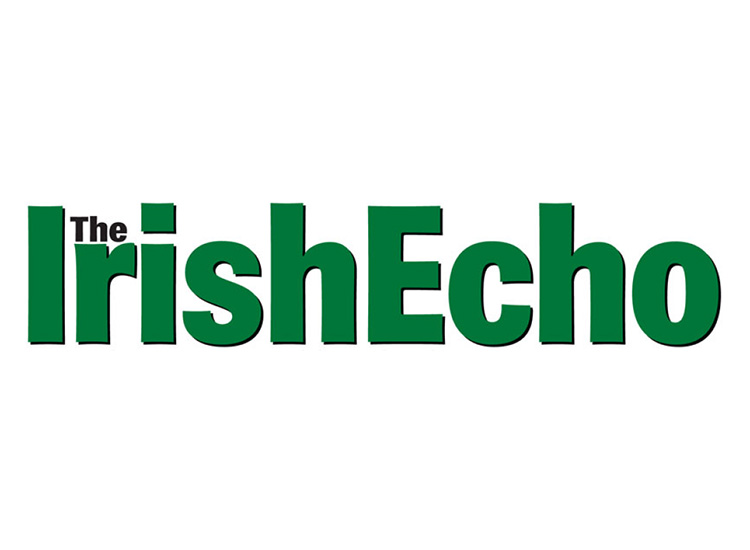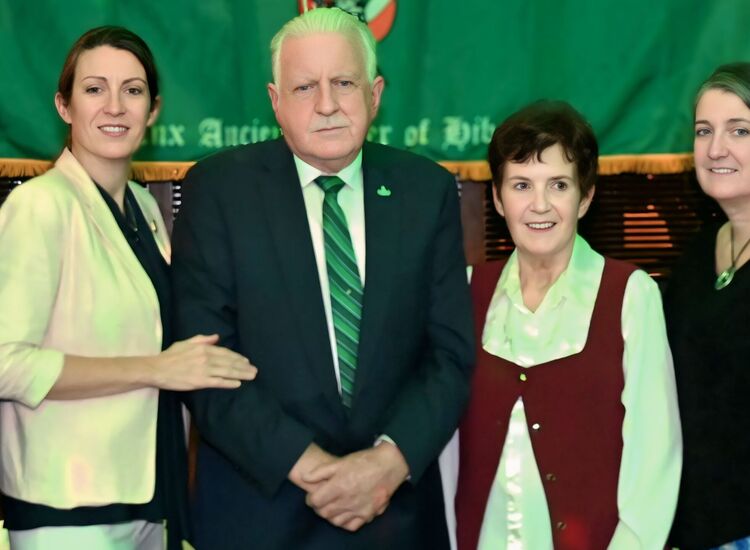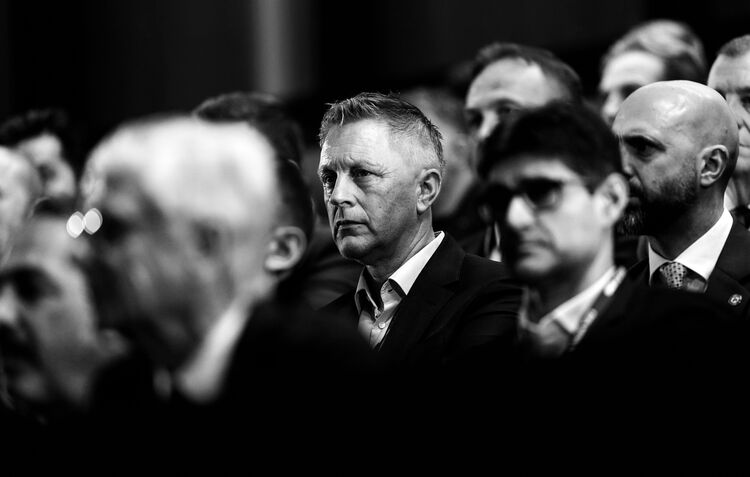Judge Daniel Cohalan.
By Peter McDermott
Michael Doorley will mark the publication of his latest book, “Justice Daniel Cohalan, 1865-1946: American patriot and Irish-American nationalist,” with a series of lectures on the Brooklyn and Long Island campuses of St. Joseph’s College from Oct. 17-22.
Doorley, an associate lecturer in history with the Open University in Ireland, on a visit to New York in 2016 spoke at the Glucksman Ireland House NYU symposium on the 1916 Rising. He is a graduate of University College Dublin and earned his Ph.D. at the University of Illinois at Chicago. The County Offaly native lives in Dublin with his wife and family.
His previous book is “Irish American Diaspora Nationalism: The Friends of Irish Freedom, 1916-1935” (2005). The Irish Echo asked Doorley some questions about Judge Cohalan and the new biography published by Cork University Press.

Dr. Michael Doorley.
How did you come to write a biography of Judge Cohalan?
I have a research interest in the history of the Irish diaspora in America with an emphasis on the interactions between Irish America and Ireland in the first half of the 20th century. This biography of Cohalan can serve as a means to explore this major theme.
If people had ever heard of Cohalan before now, it’s usually in association with his bitter dispute with Éamon de Valera during the latter’s 18-month mission to America in 1919-20. The dispute is certainly important and I devote two chapters to it in my book. However, I also try to go beyond this to explore other aspects of his life which can help us to understand the nature of the Irish-American experience. A biography should be more than simply an account of an individual's life but it should also help us to understand the social and political environment in which that individual lived.
One of the key themes is Cohalan's “dual allegiance” to both the United States and the cause of Irish independence. Fundamentally, his “Americanism” influenced his Irish nationalism. Like other Irish Americans, he was sensitive to allegations that Irish Catholics were not fully loyal to the United States. He believed that the Irish-American nationalist strategy in the U.S. should reflect this situation and should be shaped by Americans rather than “visitors” from Ireland.

Éamon de Valera.
What were Cohalan’s goals?
I would see Cohalan pursuing, as he saw it, three complementary goals. Firstly, Cohalan strove to achieve Irish independence which he viewed as best achieved by revolutionary means. He could therefore be placed in that Irish-American revolutionary tradition of the American Fenians and the Clan. He was a prominent member of the latter group for some years and remained an unwavering ally of Clan leader John Devoy to the end.
Secondly, Cohalan was conscious of the inferior status of the Catholic Irish in the United States. Of course, this was in no way comparable to the status of African-Americans or Asians or Native Americans. The Irish were legally white and had improved their social position since the Famine. However, there was still a legacy of discrimination against Irish Catholics and the Irish in general as illustrated by the anti-Catholic feeling aroused during Al Smith’s failed presidential bid in 1928. His involvement in such organizations as the American Irish Historical Society could be seen in the context of trying to enhance the status of the Irish in the United States. His belief that the Irish-American movement should be led by Americans would also be related to this theme and impacted on his conflict with de Valera.
Finally, Cohalan believed that elements of the Anglo-Saxon elite in the United States were pro-British and that Britain was trying to entrap the United States into an alliance which would enhance the power of the British Empire. In my book, I argue that he tended to go too far with this. He believed that American policy was motivated by the pro-British sentiments of Wilson and Roosevelt. In reality, the United States was motivated by its own self interests.
Throughout his career, he devoted himself to combating what he saw as internationalist tendencies in American foreign policy. He remained deeply opposed to American involvement in international organizations such as the League of Nations and the World Court. He also opposed American entry into both the First World War and the Second World War. There was a strong isolationist sentiment in the United States in the 1930s and Cohalan was not alone in speaking out against American involvement in another conflict in Europe.
Tell us something about his background.
Daniel Cohalan was born in Middletown in Orange County, New York, in December 1865 to Irish-born parents. He spent all of his adult life in New York City and died there in November 1946. Daniel’s father Timothy Cohalan was from Courtmacsherry in County Cork and left Ireland during the Great Famine. His mother Ellen O’Leary, also from Courtmacsherry, emigrated in 1853. Daniel’s father owned a prosperous glass-making business and sent Daniel and his four brothers to Manhattan College. Interestingly, all of the Cohalan brothers became lawyers and the family’s association with the New York legal profession continued down through the generations. Cohalan became very wealthy and purchased a large summer home in Glandore, Co. Cork, which he visited frequently until the mid-1930s.
How big a player was he in Tammany Hall politics?
Like many politically ambitious Irish-American lawyers, Cohalan joined the New York Democratic Party organization, also known as Tammany Hall in 1902. Boss Charlie Murphy appreciated his legal skills and in 1908 he became Grand Sachem of Tammany Hall. This was a very senior leadership post within the organization. By tradition, Tammany Hall used Native American words to describe features of their organization. “Sachem” meant chief while the building where Tammany meetings were held was called the “Wigwam.” Through his Tammany connections, Cohalan became a State Supreme Court Justice in 1911 and his tenure as Grand Sachem came to an end. However, he continued to maintain links to the Tammany organization until the 1930s.
As a revolutionary nationalist in the Fenian tradition, what was his relationship like with U.S.-based supporters of John Redmond?
Cohalan was a bitter opponent of Home Rule and Irish Parliamentary leader John Redmond. Cohalan saw Home Rule as insufficient for Irish national demands and he also believed that it would make Ireland an ally of the British Empire. Redmond maintained a support organization in the United States known as the United Irish League of America. This organization was popular in in the years before the outbreak of war 1914 as the granting of Home Rule seemed imminent. In his speeches and correspondence, Cohalan made every effort to try to dissuade Irish-American from joining the UILA.
He was against imperialism, you write, whether it was British or American or French. Is there any record of his views on race?
His views on race must be seen in the context of the times in which he lived. Cohalan challenged the view that all Americans needed to be measured against an Anglo-Saxon ideal. In an interview with Metropolis magazine in 1921, Cohalan argued that the contributions of all races to American life should be valued hence his association with the American Irish Historical Society In a 1924 letter to his son Florence, Cohalan argued that: “We are not truly free until all citizens stand upon an actual as well as a theoretical equality in the public life of the country.”
It is important to note that until the 1920s, the Irish were regarded by many in America as belonging to a separate race. Indeed Irish-American leaders commonly used the term “race” to define their own sense of Irish identity. For instance, three large “Irish Race Conventions” were held in the United States – in 1916, 1918 and 1919. These attracted thousands of delegates. The term “Americans of Irish blood” was often freely used, often by the Irish themselves.
One of Cohalan’s blind spots was that he did not speak out against the much more severe discrimination suffered by African Americans and other non-white groups at this time. Instead, he remained primarily focused on the interests of Irish in America. During the peak of his power in 1919 and 1920, he was often described by his supporters as the “leader of the Irish Race in America.”
When it came to backing the Anglo-Irish Treaty, was he influenced in any way by the personalities involved or did his support for it accord with his own innate pragmatism?
There is no doubt that his personal antipathy to de Valera influenced his support for the Treaty. He denounced de Valera for his opposition describing him as a “jealous and disappointed egotist.” However, he took a pragmatic approach to the Treaty debate and believed that it was the best deal that could be obtained in the circumstances. Indeed, most Irish-Americans supported the Treaty and Cohalan was representative of this view.
Tell us about his relationship with W.T. Cosgrave, who became head of the Irish government after Michael Collins was killed in 1922.
He developed a friendship with Cosgrave who was the president of the Executive Council of the Irish Free State. He even traveled to Ireland in the summer of 1923 and campaigned openly in support of Cosgrave during the election campaign of that year. He was still a New York State Supreme Court Justice at this time.
However, it was not all plain sailing and he was critical of the Free State’s entry into the League of Nations. He also criticized Cosgrave’s handling of the Irish army mutiny of 1924. Cosgrave turned a blind eye to this criticism since he valued Cohalan’s American political and corporate contacts.

W.T. Cosgrave.
Your penultimate chapter is entitled "Defending Jeffersonian Democracy in the Great Depression." Please explain.
Cohalan disliked Franklin Roosevelt and along with other prominent democrats such as Al Smith, he tried to prevent his re-nomination as a presidential candidate at the 1936 Democratic Convention. This attempt failed. Cohalan compared Roosevelt’s New Deal response to the Great Depression to the “collectivist policies” pursued by some of the European dictators of that time. In attacking the New Deal, Cohalan often cited Thomas Jefferson’s opposition to a strong Federal government. In this regard, Cohalan was out of step with most Irish Americans who supported Roosevelt in vast numbers – including his own brother, John P. Cohalan, who often visited the Roosevelt residence in Hyde Park.

Judge Daniel Cohalan pictured in the late 1920s in the center of the back row with his sons, from left, Con, Dan Jr., Patrick and Florence. His wife Madge is in the center of the front row with his daughters Aileen, left, and Kathleen. All six were the children of Madge’s sister Hanna, who died in childbirth in 1911, as did her baby. Florence’s twin brother died in 1915 and Cohalan and Madge’s only child, a daughter, died at age 6 in 1923. Aileen became a Sacred Heart sister in 1930, Patrick joined the Jesuits, while Florence (a popular name for males in Cork) also became a priest and went on to become a monsignor in the Archdiocese of New York. Con and Dan Jr. were lawyers, while Kathleen was for many years the librarian of the American Irish Historical Society.
Did you meet with family members in the course of your research?
Yes, I did meet with Peter Fox Cohalan who is himself a retired New York State Supreme Court Justice (though from the Republican side of the aisle). Peter is a great nephew of Daniel Cohalan and a grandson of John P. Cohalan, the brother who was friendly with Roosevelt. Apparently, the two brothers, Daniel and John P., did not see eye to eye on a lot of things.
Peter Fox Cohalan is himself a historian and has done a great deal of work with the Suffolk County Historical Society over many years. Peter provided me with great insights into the experience of the Cohalan family in the United States and allowed me access to his family papers and photographs. These family photos were invaluable in helping me compile the St Joseph's College digital exhibition on the life of Daniel Cohalan. This can be viewed on the St. Josephs College website.

Peter Fox Cohalan and his son, army veteran Pierce Cohalan, who has been a Suffolk County District Court Judge since 2015, thus continuing the long Cohalan tradition of service in New York's judiciary.
Cohalan lectures at St. Joseph’s College
Dr. Michael Doorley’s four lectures at St. Joseph College’s Brooklyn and Long Island campuses are sponsored by the Robert David Lion Gardiner Foundation. Doorley will discuss his biography of Judge Cohalan, which chronicles the influential role that he played in early 20th century New York state politics and the Irish nationalist movement.
All events are free and open to the public, though the second of the four requires a reservation. The series will take place at SJC Long Island and SJC Brooklyn as follows:
Thursday, Oct. 17, 12:40 to 1:30 p.m. in the McGann Conference Center, O’Connor Hall, SJC Long Island, 319 West Roe Blvd, Patchogue
Thursday Oct. 17, 6 to 8 p.m. at the Suffolk County Historical Society (reservations required, please contact Dr. Mark Hessler at mhessler@sjcny.edu)
Monday, Oct. 21 12:40 p.m. to 1:30 p.m. SJC Brooklyn, Tuohy Hall Student Lounge, 245 Clinton Avenue, Brooklyn.
Tuesday, Oct. 22, 6 to 8 p.m. at the Brooklyn Historical Society, Great Hall and Fransioli Gallery.
“Cohalan is fascinating in that he was a major power broker in both New York City politics and the Irish nationalist movement simultaneously during a period of significant flux,” the college said in a statement. “Guests at these lectures will learn how he navigated not only the reform/Progressive Era in local politics but also how he managed the American response both in advance of the Easter Rising and the de Valera/pro-Treaty schism in the Irish community.”
Aside from his two books, Dr. Doorley has published widely on the history of the Irish diaspora in the United States including chapters in the landmark volumes, “Ireland’s Allies: America and the 1916 Easter Rising” (2016), and “The Atlas of the Irish Revolution” (2017).








